window relay BMW 740IL 1996 E38 Central Body Electronics ZKE Manual
[x] Cancel search | Manufacturer: BMW, Model Year: 1996, Model line: 740IL, Model: BMW 740IL 1996 E38Pages: 80, PDF Size: 4.14 MB
Page 16 of 80
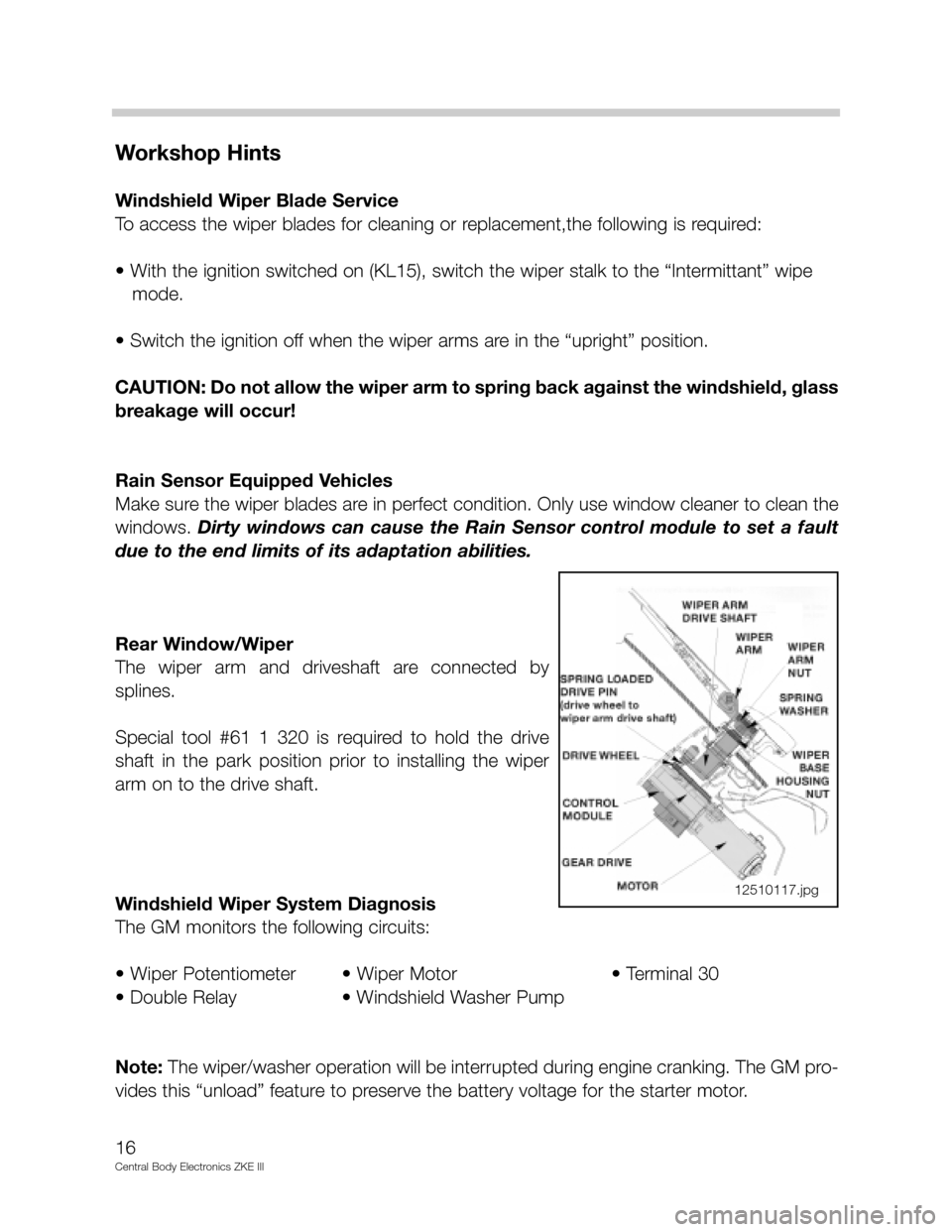
Workshop Hints
Windshield Wiper Blade Service
To access the wiper blades for cleaning or replacement,the following is required:
• With the ignition switched on (KL15), switch the wiper stalk to the “Intermittant” wipe
mode.
• Switch the ignition off when the wiper arms are in the “upright” position.
CAUTION: Do not allow the wiper arm to spring back against the windshield, glass
breakage will occur!
Rain Sensor Equipped Vehicles
Make sure the wiper blades are in perfect condition. Only use window cleaner to clean the
windows. Dirty windows can cause the Rain Sensor control module to set a fault
due to the end limits of its adaptation abilities.
Rear Window/Wiper
The wiper arm and driveshaft are connected by
splines.
Special tool #61 1 320 is required to hold the drive
shaft in the park position prior to installing the wiper
arm on to the drive shaft.
Windshield Wiper System Diagnosis
The GM monitors the following circuits:
• Wiper Potentiometer • Wiper Motor • Terminal 30
• Double Relay • Windshield Washer Pump
Note: The wiper/washer operation will be interrupted during engine cranking. The GM pro-
vides this “unload” feature to preserve the battery voltage for the starter motor.
16
Central Body Electronics ZKE III
12510117.jpg
Page 20 of 80
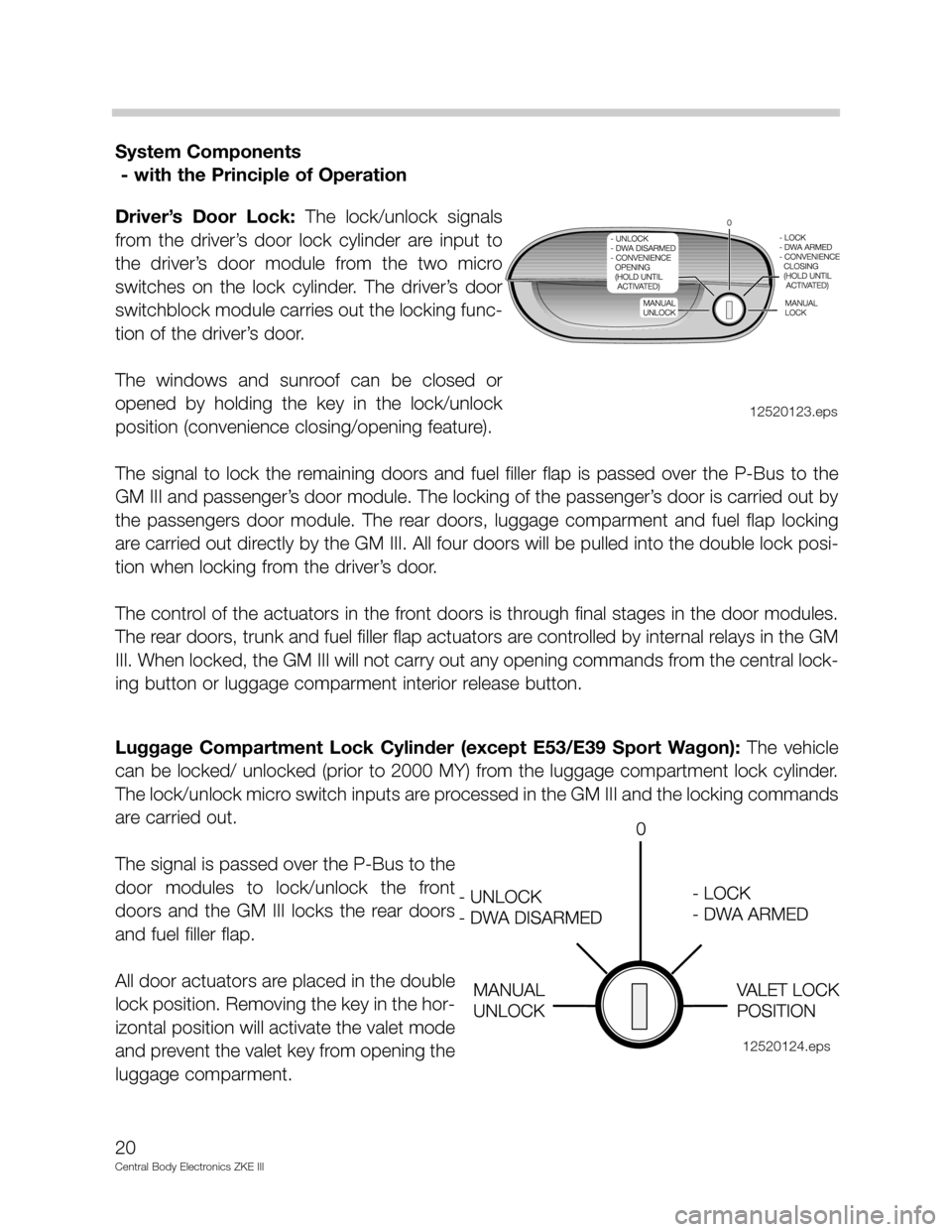
System Components
- with the Principle of Operation
Driver’s Door Lock: The lock/unlock signals
from the driver’s door lock cylinder are input to
the driver’s door module from the two micro
switches on the lock cylinder. The driver’s door
switchblock module carries out the locking func-
tion of the driver’s door.
The windows and sunroof can be closed or
opened by holding the key in the lock/unlock
position (convenience closing/opening feature).
The signal to lock the remaining doors and fuel filler flap is passed over the P-Bus to the
GM III and passenger’s door module. The locking of the passenger’s door is carried out by
the passengers door module. The rear doors, luggage comparment and fuel flap locking
are carried out directly by the GM III. All four doors will be pulled into the double lock posi-
tion when locking from the driver’s door.
The control of the actuators in the front doors is through final stages in the door modules.
The rear doors, trunk and fuel filler flap actuators are controlled by internal relays in the GM
III. When locked, the GM III will not carry out any opening commands from the central lock-
ing button or luggage comparment interior release button.
Luggage Compartment Lock Cylinder (except E53/E39 Sport Wagon): The vehicle
can be locked/ unlocked (prior to 2000 MY) from the luggage compartment lock cylinder.
The lock/unlock micro switch inputs are processed in the GM III and the locking commands
are carried out.
The signal is passed over the P-Bus to the
door modules to lock/unlock the front
doors and the GM III locks the rear doors
and fuel filler flap.
All door actuators are placed in the double
lock position. Removing the key in the hor-
izontal position will activate the valet mode
and prevent the valet key from opening the
luggage comparment.
20
Central Body Electronics ZKE III
12520123.eps
12520124.eps
Page 25 of 80
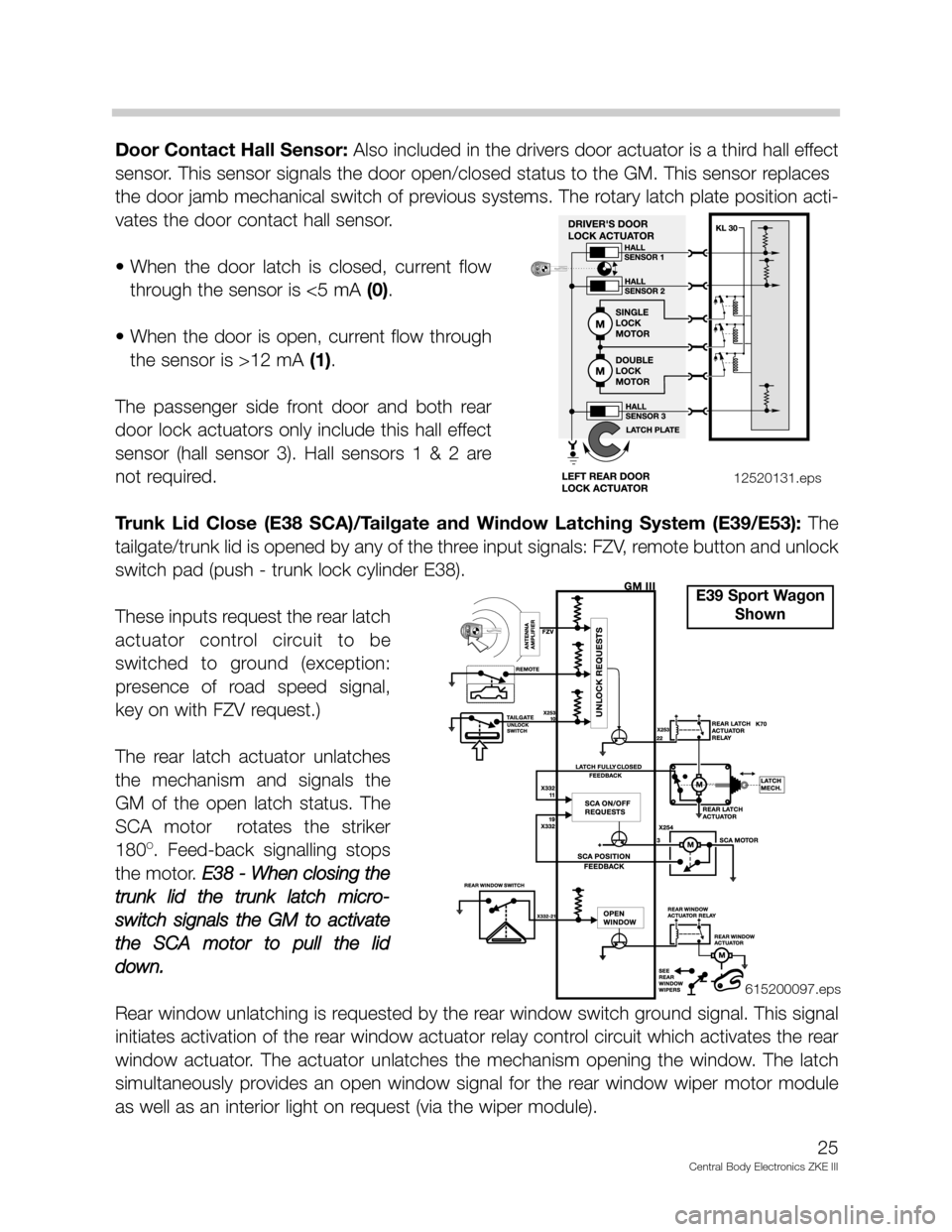
Door Contact Hall Sensor: Also included in the drivers door actuator is a third hall effect
sensor. This sensor signals the door open/closed status to the GM. This sensor replaces
the door jamb mechanical switch of previous systems. The rotary latch plate position acti-
vates the door contact hall sensor.
• When the door latch is closed, current flow
through the sensor is <5 mA (0).
• When the door is open, current flow through
the sensor is >12 mA (1).
The passenger side front door and both rear
door lock actuators only include this hall effect
sensor (hall sensor 3). Hall sensors 1 & 2 are
not required.
Trunk Lid Close (E38 SCA)/Tailgate and Window Latching System (E39/E53): The
tailgate/trunk lid is opened by any of the three input signals: FZV, remote button and unlock
switch pad (push - trunk lock cylinder E38).
These inputs request the rear latch
actuator control circuit to be
switched to ground (exception:
presence of road speed signal,
key on with FZV request.)
The rear latch actuator unlatches
the mechanism and signals the
GM of the open latch status. The
SCA motor rotates the striker
180
O. Feed-back signalling stops
the motor. E38 - When closing the
trunk lid the trunk latch micro-
switch signals the GM to activate
the SCA motor to pull the lid
down.
Rear window unlatching is requested by the rear window switch ground signal. This signal
initiates activation of the rear window actuator relay control circuit which activates the rear
window actuator. The actuator unlatches the mechanism opening the window. The latch
simultaneously provides an open window signal for the rear window wiper motor module
as well as an interior light on request (via the wiper module).
25
Central Body Electronics ZKE III
12520131.eps
E39 Sport Wagon
Shown
615200097.eps
Page 43 of 80
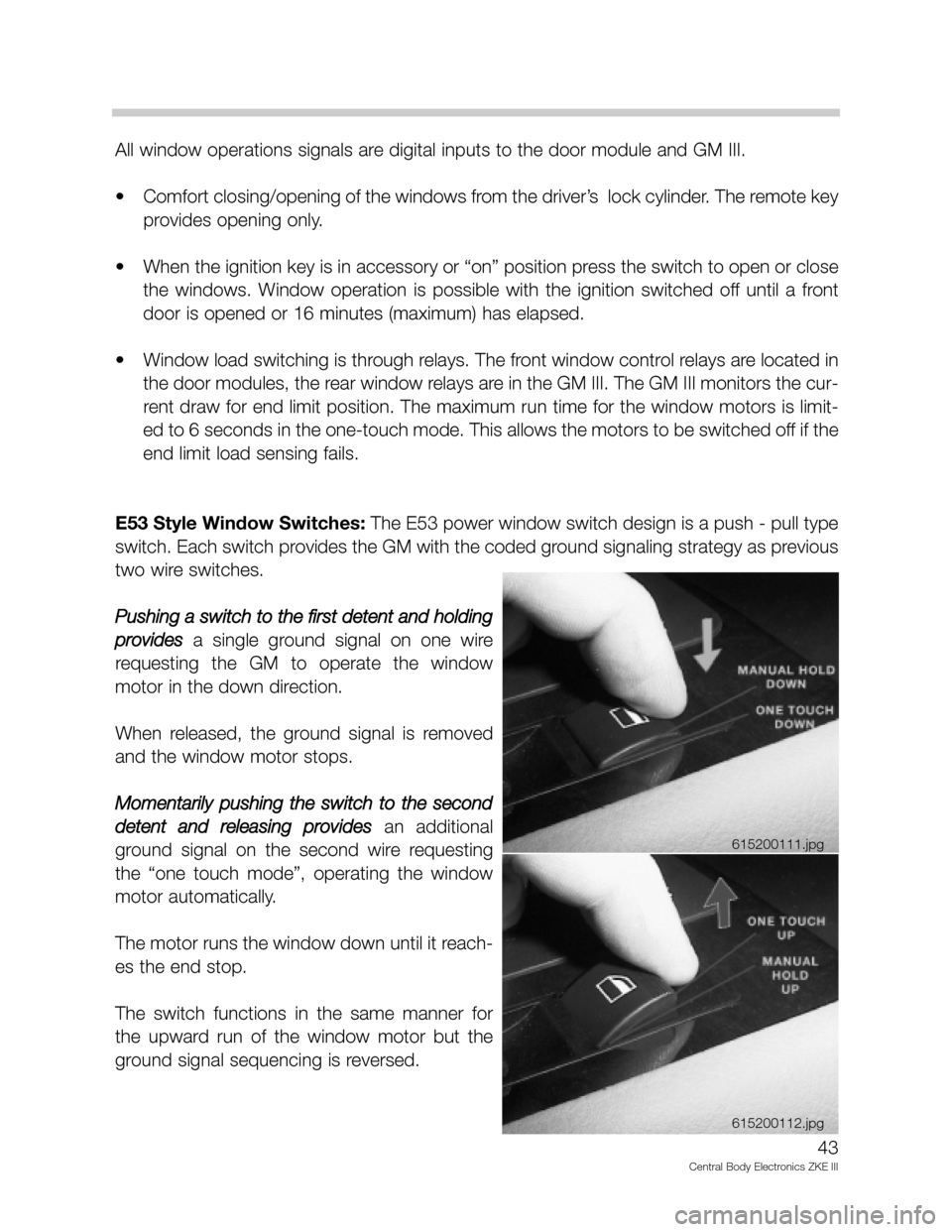
All window operations signals are digital inputs to the door module and GM III.
• Comfort closing/opening of the windows from the driver’s lock cylinder. The remote key
provides opening only.
• When the ignition key is in accessory or “on” position press the switch to open or close
the windows. Window operation is possible with the ignition switched off until a front
door is opened or 16 minutes (maximum) has elapsed.
• Window load switching is through relays. The front window control relays are located in
the door modules, the rear window relays are in the GM III. The GM III monitors the cur-
rent draw for end limit position. The maximum run time for the window motors is limit-
ed to 6 seconds in the one-touch mode. This allows the motors to be switched off if the
end limit load sensing fails.
E53 Style Window Switches:The E53 power window switch design is a push - pull type
switch. Each switch provides the GM with the coded ground signaling strategy as previous
two wire switches.
Pushing a switch to the first detent and holding
provides
a single ground signal on one wire
requesting the GM to operate the window
motor in the down direction.
When released, the ground signal is removed
and the window motor stops.
Momentarily pushing the switch to the second
detent and releasing provides
an additional
ground signal on the second wire requesting
the “one touch mode”, operating the window
motor automatically.
The motor runs the window down until it reach-
es the end stop.
The switch functions in the same manner for
the upward run of the window motor but the
ground signal sequencing is reversed.
43
Central Body Electronics ZKE III
615200111.jpg
615200112.jpg
Page 46 of 80
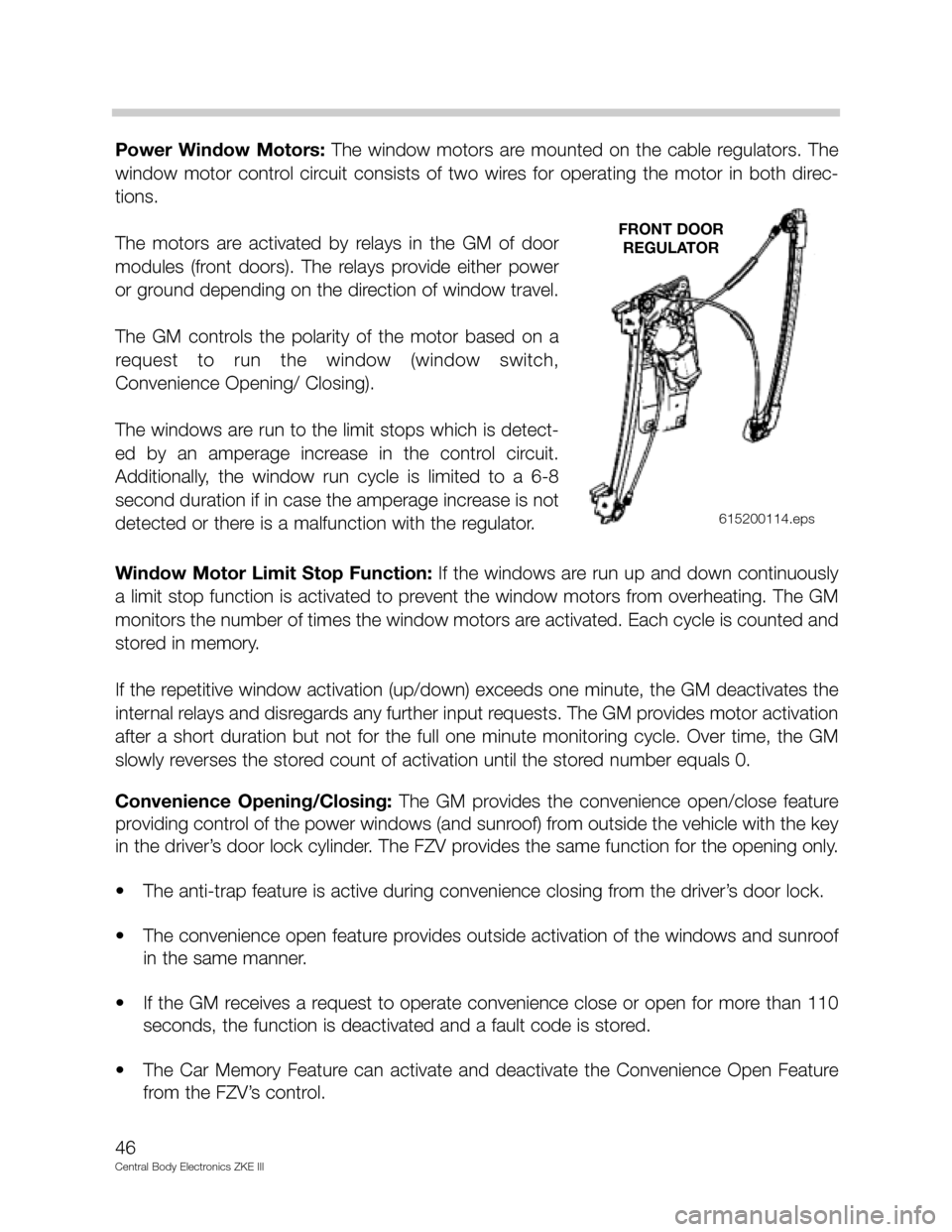
Power Window Motors: The window motors are mounted on the cable regulators. The
window motor control circuit consists of two wires for operating the motor in both direc-
tions.
The motors are activated by relays in the GM of door
modules (front doors). The relays provide either power
or ground depending on the direction of window travel.
The GM controls the polarity of the motor based on a
request to run the window (window switch,
Convenience Opening/ Closing).
The windows are run to the limit stops which is detect-
ed by an amperage increase in the control circuit.
Additionally, the window run cycle is limited to a 6-8
second duration if in case the amperage increase is not
detected or there is a malfunction with the regulator.
Window Motor Limit Stop Function: If the windows are run up and down continuously
a limit stop function is activated to prevent the window motors from overheating. The GM
monitors the number of times the window motors are activated. Each cycle is counted and
stored in memory.
If the repetitive window activation (up/down) exceeds one minute, the GM deactivates the
internal relays and disregards any further input requests. The GM provides motor activation
after a short duration but not for the full one minute monitoring cycle. Over time, the GM
slowly reverses the stored count of activation until the stored number equals 0.
Convenience Opening/Closing: The GM provides the convenience open/close feature
providing control of the power windows (and sunroof) from outside the vehicle with the key
in the driver’s door lock cylinder. The FZV provides the same function for the opening only.
• The anti-trap feature is active during convenience closing from the driver’s door lock.
• The convenience open feature provides outside activation of the windows and sunroof
in the same manner.
• If the GM receives a request to operate convenience close or open for more than 110
seconds, the function is deactivated and a fault code is stored.
• The Car Memory Feature can activate and deactivate the Convenience Open Feature
from the FZV’s control.
46
Central Body Electronics ZKE III
FRONT DOOR
REGULATOR
615200114.eps